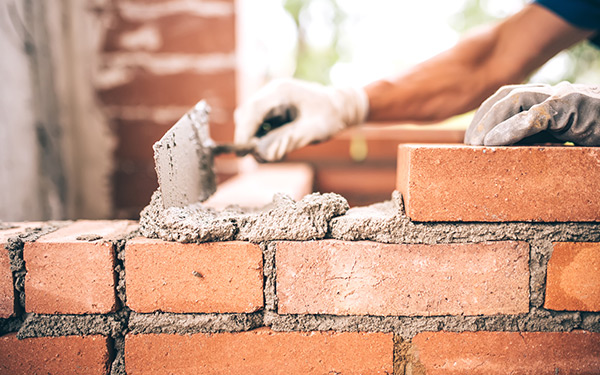Opening the Keys of Lasting Stonework Building And Construction Practices for Eco-Friendly Buildings
In the world of modern-day building and construction, the search of lasting practices has ended up being extremely important. Among the myriad methods to green structure, sustainable masonry building sticks out as a time-tested and durable technique that holds a riches of untapped capacity. From the option of materials to ingenious building and construction techniques, the secrets to achieving sustainability within masonry building are complex and fascinating. By exploring the advantages, products, methods, and future fads of lasting stonework, a much deeper understanding of just how these methods can shape the future of environmentally friendly buildings emerges.
Advantages of Lasting Masonry Construction
Accepting sustainable stonework building and construction methods not just decreases environmental impact however likewise uses lasting economic benefits to building contractors and communities. By using products like recycled bricks, blocks, and rocks, home builders can considerably lower the carbon footprint of their jobs while promoting source performance. In addition, lasting masonry building techniques, such as appropriate insulation and thermal mass residential or commercial properties, can improve power performance within structures, bring about reduced functional costs in time.
Additionally, the durability and resilience of masonry structures contribute to long-term economic benefits. Buildings built using sustainable masonry practices usually need less repair and maintenance, translating to set you back financial savings for builders and homeowner. The long life of masonry materials also ensures that frameworks stay steady and secure, decreasing the requirement for regular remodellings or replacements.
Eco-Friendly Stonework Materials
Utilizing environmentally friendly stonework materials is a crucial action towards enhancing the sustainability of construction techniques and reducing environmental influence while making best use of long-term financial benefits. Lasting masonry products are sourced, produced, and used in a way that reduces total environmental influence. Materials such as recycled blocks, recovered rock, and sustainable concrete blocks are becoming significantly popular selections for eco-conscious home builders. Recycled blocks, for instance, not only divert waste from garbage dumps however likewise need much less energy to generate compared to new blocks. Reclaimed rock uses a special aesthetic charm while reducing the requirement for brand-new quarrying. Sustainable concrete blocks include recycled accumulations and might include improved insulation homes, adding to energy effectiveness in structures.
Additionally, natural materials like adobe, rammed planet, and straw bundles offer excellent thermal mass properties, lowering the need for heating and cooling down power. These products are commonly in your area readily available, promoting regional economic situations and minimizing transportation-related carbon emissions. By selecting environment-friendly masonry materials, construction jobs can significantly reduce their environmental impact and add to the production of much healthier, a lot more sustainable developed settings.
Energy-Efficient Stonework Techniques
Energy performance plays a crucial role in boosting the sustainability of stonework building and construction practices. By implementing energy-efficient stonework methods, contractors can dramatically lower the general energy usage of a building, causing lower functional prices and a smaller environmental footprint. One essential energy-efficient stonework strategy is the usage of thermal mass, which includes including thick materials luxury auto like concrete or brick right into the building's structure to absorb and store warm. This helps manage interior temperatures, decreasing the demand for mechanical home heating and cooling systems.

Advancements in Sustainable Stonework
Current improvements in lasting masonry practices have brought around innovative techniques that are improving the construction industry. One such innovation is the development of self-healing concrete, which makes use of microorganisms installed within the concrete to heal splits autonomously. This innovation not just lowers upkeep expenses but also boosts the durability of stonework structures, contributing to their sustainability.
Another remarkable development is making use of recycled accumulations in masonry building and construction - masonry contractor. By integrating materials such as smashed ceramic waste or recycled glass into concrete blends, building contractors can lower the ecological effect of construction projects while keeping architectural honesty. This practice not only draws away waste from garbage dumps but additionally saves natural sources, making it a key advancement in sustainable masonry building and construction
Moreover, the integration of electronic layout tools, such as Structure Info Modeling (BIM), is changing the method stonework structures are intended and constructed. BIM enables even more precise calculations, minimized material waste, chevy near me and improved energy performance, ultimately leading to even more sustainable building methods. These developments jointly signify an encouraging future for sustainable stonework building in the age of eco-friendly buildings.
Future Trends in Masonry Sustainability
With the ingenious strides made in lasting masonry methods, the future trends in masonry sustainability are poised to more revolutionize the building sector. One of the vital trends shaping the future of masonry sustainability is the boosted assimilation of technology. Advancements such as Building Info Modeling (BIM) and digital truth simulations are being made use of to optimize masonry building procedures, bring about decreased product waste and boosted power efficiency in structures.
Furthermore, the development of novel sustainable materials is readied to play a substantial role in improving the eco-friendliness of stonework building and construction. masonry contractor. Advancements like self-healing concrete, recycled aggregates, and bio-based binders are gaining traction for their ability to lessen ecological impact while maintaining structural stability

Conclusion
In conclusion, sustainable stonework building and construction practices use numerous advantages for eco-friendly buildings. masonry contractor. Innovations in sustainable masonry are constantly being created to further enhance the environmental efficiency of structures.